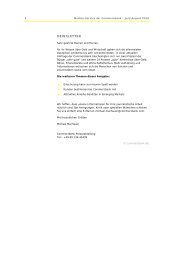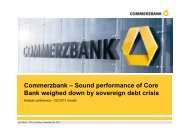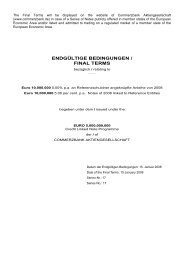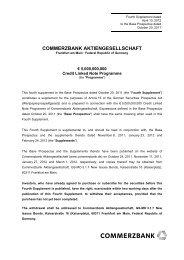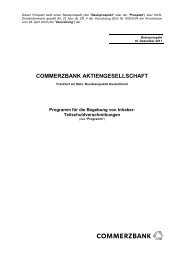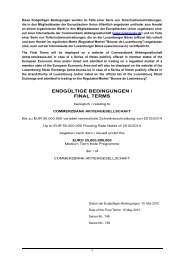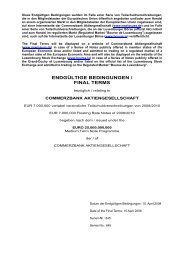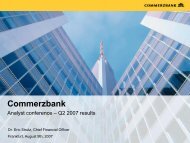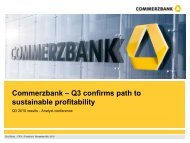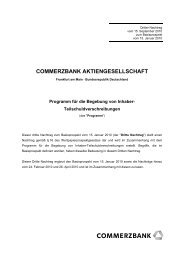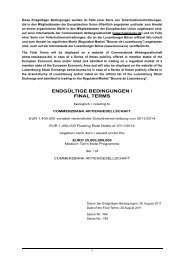financial statements and management report 2004 commerzbank ag
financial statements and management report 2004 commerzbank ag
financial statements and management report 2004 commerzbank ag
Create successful ePaper yourself
Turn your PDF publications into a flip-book with our unique Google optimized e-Paper software.
equirements for banks using state-of-the-art rating<br />
procedures with a high discriminatory power, Basel II<br />
promotes competition between banks to develop<br />
such methods. However, improved rating systems are<br />
by no means simply a regulatory necessity; rather,<br />
they are in the very interest of the bank itself. Only by<br />
consciously taking well-known risks will it be possible<br />
to do business successfully in the future.<br />
Commerzbank has recognized the structural<br />
change in the German credit market <strong>and</strong> the regulatory<br />
requirements set by the Basel capital adequacy<br />
rules as an opportunity <strong>and</strong> is currently subjecting its<br />
existing rating systems to efficient expert <strong>and</strong> technical<br />
checks <strong>and</strong> also revision. This will enable the Bank<br />
to man<strong>ag</strong>e credit risk better in future <strong>and</strong> to assign<br />
credit commitments to rating classes more reliably,<br />
thereby reducing loan-loss provisioning <strong>and</strong> lowering<br />
the opportunity cost for lost business.<br />
Commerzbank Master Scale<br />
At the start of 2005, Commerzbank introduced a new<br />
uniform rating scale, which is also binding for its<br />
branches in Germany <strong>and</strong> abroad. The Commerzbank<br />
Master Scale remains constant over both customer<br />
segments <strong>and</strong> periods of time. This has the advant<strong>ag</strong>e<br />
that all customers can be directly compared with<br />
one another <strong>and</strong> all rating categories can be presented<br />
<strong>and</strong> interpreted in a uniform manner. In addition,<br />
assignment to the Commerzbank rating classes<br />
makes it possible for them to be included in the rating<br />
system of external rating <strong>ag</strong>encies <strong>and</strong> the so-called<br />
IFD scale of the Finance Initiative Germany (Initiative<br />
Finanzplatz Deutschl<strong>and</strong>).<br />
In order to meet the requirements for both exactness<br />
<strong>and</strong> stability, the existing rating scale has been<br />
differentiated further to form 25 rating classes for<br />
“living” business (from 1.0 to 5.8). This will enable<br />
the Bank to make finer distinctions as regards creditworthiness<br />
for all customer groups <strong>and</strong> to clearly<br />
define <strong>and</strong> compare the PDs (probability of default)<br />
<strong>and</strong> ELs (expected loss) both over time <strong>and</strong> cross-sectionally.<br />
Although the Basel II rules prescribe only<br />
one default class, Commerzbank has decided to<br />
define five classes of default. On the one h<strong>and</strong>, this<br />
substantially increases transparency in the high-risk<br />
area while, on the other, considerably improving the<br />
allocation of provisioning together with selective<br />
RISK REPORT 11<br />
work-out measures based on the respective situation<br />
of the individual case.<br />
The Commerzbank Master Scale has been applied<br />
in the Bank’s corporate-customer ratings since the<br />
start of 2005. As new rating methods for banks, specialized<br />
finance, ships <strong>and</strong> other customer groups are<br />
introduced step by step in the course of the year, the<br />
master scale will become binding for these segments<br />
as well. This also holds true for the retail area.<br />
Assessing creditworthiness in retail business<br />
In its retail lending, Commerzbank has successfully<br />
used application scoring procedures <strong>and</strong> rating<br />
methods for assessing the creditworthiness of both<br />
dependently employed borrowers <strong>and</strong> business customers<br />
for several years now. All of the methods<br />
employed are computer-based <strong>and</strong> draw upon highly<br />
reliable, predominantly mathematical-statistical<br />
methods for the early recognition of risk <strong>and</strong> the<br />
assessment of the risk of default.<br />
Thanks to its universally applied behaviouralscoring<br />
procedure, the Bank is able to monitor <strong>and</strong><br />
adjust limits permanently <strong>and</strong> fully automatically<br />
– taking into account in-payments <strong>and</strong> the customer’s<br />
payment record – for over one million customers who<br />
maintain accounts for payment transactions or have<br />
taken up loans. The procedure is complemented by<br />
early warnings to the responsible decision-makers in<br />
given situations, ensuring a proactive steering of risk.<br />
Behavioural scoring is being extended in the current<br />
year to business customers who are not obliged to<br />
prepare a balance sheet.<br />
The scoring <strong>and</strong> rating procedures, whose<br />
employment depends on the customer group in question<br />
or the credit type, were further refined in <strong>2004</strong><br />
for virtually all the Bank’s portfolios, with the aim of<br />
achieving procedures validated by mathematicalstatistical<br />
methods. The objective is to constantly<br />
improve the discriminatory power, thereby raising<br />
the Gini coefficient. Commerzbank always seeks to be<br />
the benchmark for the quality of risk-<strong>man<strong>ag</strong>ement</strong><br />
systems <strong>and</strong> in this way further reduce the decision<br />
errors for intended <strong>and</strong> unintended business. Even<br />
now, the behavioural-scoring procedure developed<br />
by Commerzbank meets the relevant Basel II requirements.<br />
The scoring/rating procedures are also<br />
becoming ever more significant in risk-based pricing.



